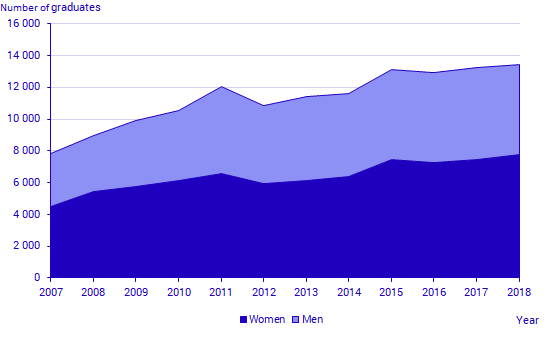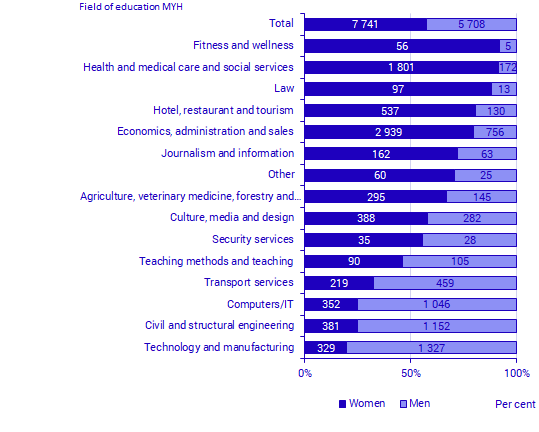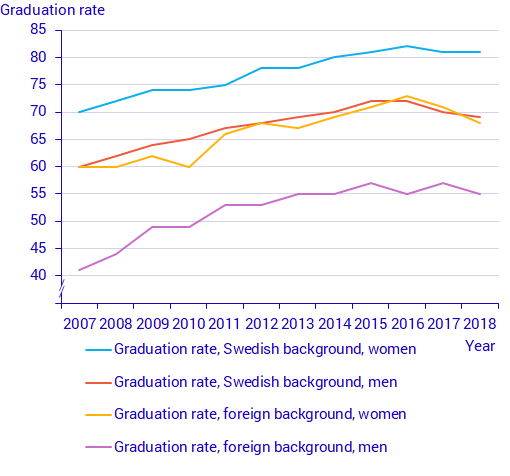Graduated from higher vocational education 2018
More women graduated from higher vocational education in 2018
Statistical news from Statistics Sweden 2019-11-27 9.30
The number of women who graduated from higher vocational education in 2018 increased slightly compared to a year earlier. More women than men continue to graduate from higher vocational education.
In total, 13 400 persons graduated from higher vocational education in 2018, which is 200 more than in 2017. The number of men who graduated declined slightly, while the number of women who graduated increased by 300. Over time, the share of women has been larger than the share of men among graduates, and currently amounts to 58 percent.

The rise in 2011 is mainly due to the fact that programmes were granted beyond the regular application round.
Major gender differences between fields of education
The field of education with the most graduates was Economics, administration and sales, which had 3 700 graduates. Women accounted for 80 percent of graduates. The second largest field of education, Health and medical care and social services, had 2 000 graduates, over 90 percent of whom were women. In Technology and manufacturing and Civil and structural engineering, in which there were over 1 500 graduates in each field, men dominate and account for 80 percent and 75 percent of graduates, respectively.

Major differences between women and men in graduation rate
The total graduation rate in 2018 was 72 percent, compared with 73 percent in 2017. Late additions may affect this rate slightly. The graduation rate among women was 78 percent, while among men, it was 65 percent. There are also major differences between fields of education. In the five largest fields of education, the highest graduation rate, 81 percent, was in Economics, administration and sales. The lowest graduation rate, 61 percent, was in Technology and manufacturing.
Highest graduation rate among women with a Swedish background
Women with a Swedish background account for the highest graduation rate, 81 percent, while men with a foreign background account for the lowest graduation rate, 55 percent. Women with a foreign background and men with a Swedish background have a graduation rate of 68 percent and 69 percent, respectively.

Distance learning is growing, but the graduation rate is lower
The number of graduates of distance learning programmes was 300 more than a year earlier, while the number of graduates of traditional learning programmes dropped by 100. The graduation rate from distance learning programmes was 60 percent in 2018, while the corresponding figure for traditional learning programmes was 75 percent. In 2018, distance learning programmes accounted for nearly 20 percent of all graduates.
Definitions and explanations
Official statistics on higher vocational education
Since 2018, Statistics Sweden has been responsible for official statistics on higher vocational education. The statistics on graduates of higher vocational education are based on data from the National Agency for Higher Vocational Education, which in turn, received the data from education providers.
Post-secondary vocational education and training is included in the statistics for the period 2007–2013.
Graduates
‘Graduate’ refers to a person who graduates from an educational programme. Data on graduates is reported after the end of the programme and not after the actual graduation date. Late additions lead to some lag in the statistics and about 100 graduates will be added to the next publication in November 2020.
Graduation rate
‘Graduation rate’ refers to the share of graduates as a percentage of students admitted to educational programmes that offer graduation. A lag due to late reporting may affect the graduation rate.
Every educational programme is counted
Persons who have been active students in several programmes during a given period are counted once for each programme. In 2018, approximately 200 individuals had started studies in more than one programme. About ten persons graduated from more than one programme in 2018.
Field of education
‘Fields of education’ are based on the SUN 2000 classification of programmes in the fields of education used by the Swedish National Agency for Higher Vocational Education (MYH).
Next publishing will be
Statistics on students and graduates 2019 will be published in March 2020. Detailed statistics on graduates 2019 will be published in November 2020.
Statistical Database
More information is available in the Statistical Database
Feel free to use the facts from this statistical news but remember to state Source: Statistics Sweden.
